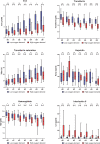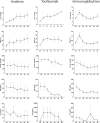Hypoferremia is Associated With Increased Hospitalization and Oxygen Demand in COVID-19 Patients
- PMID: 33205000
- PMCID: PMC7665253
- DOI: 10.1097/HS9.0000000000000492
Hypoferremia is Associated With Increased Hospitalization and Oxygen Demand in COVID-19 Patients
Abstract
Iron metabolism might play a crucial role in cytokine release syndrome in COVID-19 patients. Therefore, we assessed iron metabolism markers in COVID-19 patients for their ability to predict disease severity. COVID-19 patients referred to the Heidelberg University Hospital were retrospectively analyzed. Patients were divided into outpatients (cohort A, n = 204), inpatients (cohort B, n = 81), and outpatients later admitted to hospital because of health deterioration (cohort C, n = 23). Iron metabolism parameters were severely altered in patients of cohort B and C compared to cohort A. In multivariate regression analysis including age, gender, CRP and iron-related parameters only serum iron and ferritin were significantly associated with hospitalization. ROC analysis revealed an AUC for serum iron of 0.894 and an iron concentration <6 μmol/l as the best cutoff-point predicting hospitalization with a sensitivity of 94.7% and a specificity of 67.9%. When stratifying inpatients in a low- and high oxygen demand group serum iron levels differed significantly between these two groups and showed a high negative correlation with the inflammatory parameters IL-6, procalcitonin, and CRP. Unexpectedly, serum iron levels poorly correlate with hepcidin. We conclude that measurement of serum iron can help predicting the severity of COVID-19. The differences in serum iron availability observed between the low and high oxygen demand group suggest that disturbed iron metabolism likely plays a causal role in the pathophysiology leading to lung injury.
Copyright © 2020 the Author(s). Published by Wolters Kluwer Health, Inc. on behalf of the European Hematology Association.
Conflict of interest statement
There are no potential conflicts of interest.
Figures




References
LinkOut - more resources
Full Text Sources
Research Materials
Miscellaneous
